The Ship Cutty Sark
|
The tea clipper Cutty Sark may have been the fastest ship of her day, but the wool trade Cutty Sark obviously was. By a
wide margin, too - she won the race from Australia to England ten years out of ten under Captain Woodget.
A clipper in the tea trade made her name by her performance in the doldrums. The greater the sail area that could be
carried there without being thrown on her beam ends, the better. But for the wool trade, the supreme achievement was the
exact opposite - the strength to keep going in the huge swells and high winds of the Southern seas when lesser ships had
to hove to, to face the wind with bare poles. Small strong sails, high off the water, were the best there. And, it was there
that the staunch hull and strong stern of the Cutty Sark made her unquestionably the Queen of the Seas.
My grandfather joined her at Cardiff in June 1880 to complete his apprenticeship, just after she had been cut down for work
as a freight carrier. He lived long enough to teach me my knots. He's at right here in the 1940's, accepting yet another print
of a sailing ship as he retired after 35 years as a school trustee.
The Cutty Sark inspired much of my childhood learning. Beginning with the places my grandfather sailed to in her, I was
drawn into reading of the history and geography of the world, a fascination that has continued throughout my life.
And so it is that, after his death in 1962, I began a 1:100 Revell model of her in the rig in which he first saw her,
full of coal and being pulled out of dock.
Rigging
We know precisely her rigging as a tea clipper, for we still have Jock Willis' specification for her
and the work book of her carpenter detailing the exact sizes of every stick of her. But, there seems to be no document that
survives to detail her rig after she was cut down. All we have is a work order, dated March 1880, specifying that her lower
masts were to be reduced by 9'6", the lower yards shortened by 7', other spars 'in proportion', and the skysail mast and
stunsails removed.
There is, however, a superb photograph of her taken a few years later by Captain Woodget in Sydney harbour. My
grandfather got a copy early this century, also the photo below it, either from Sir Basil or from Captain Woodget. It is shown
at right. The rigging is squared to perfection, and the photo can be scaled (perspective-corrected) to a consistency of a few
percent except for the bowsprit and gaffs.
Here are the results of my scaling relative to the hull, compared to the original lengths quoted in
The Log of the Cutty Sark, Basil Lubbock:
| mast heights above deck m | yard lengths m
|
|---|
| Tea rig | Sydney | | Tea rig | Sydney
|
|---|
| foretop | 18.8 | 16.5 | fore course | 23.8 | 21.0
| | topgallant | 29.8 | 24.3 | lowertopsail | 20.7 | 16.8
| | royal | 39.6 | 35.4 | uppertopsail | 19.5 | 14.6
| | maintop | 19.8 | 16.9 | topgallant | 14.6 | 11.5
| | topgallant | 31.9 | 22.8 | royal | 11.6 | 9.4
| | royal | | 36.3 | main course | 23.8 | 21.6
| | skysail | 44.5 | | lowertopsail | 20.7 | 18.5
| | mizzentop | 17.0 | 14.8 | uppertopsail | 19.5 | 16.8
| | topgallant | 25.7 | 22.8 | topgallant | 14.6 | 14.2
| | royal | 33.2 | 31.7 | royal | 11.6 | 10.4
| | skysail | 10.4
| | mizzen course | 18.3 | 17.4
| | lowertopsail | 16.5 | 14.9
| | uppertopsail | 14.6 | 13.4
| | topgallant | 11.9 | 11.0
| | royal | 10.1 | 8.2
| | spanker | 15.8 | 14.1
|
|
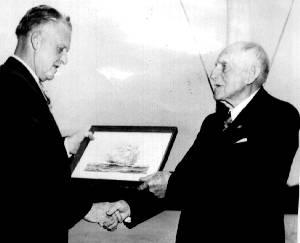
my grandfather
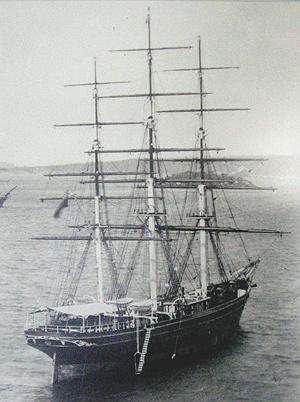
the Cutty Sark in Sydney harbour
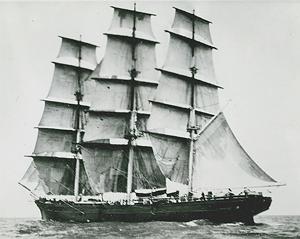
becalmed in the Doldrums
|
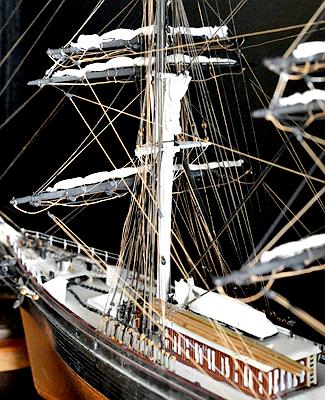
These measurements are reasonably close to the dock order except for some of the top yards, which are shorter. This is the
way I'm making it. And, despite grandfather, without stunsails because I don't know how many were present during his
voyage, nor which ones. The original kit was for a simplified rigging, but Revell
kindly provided me with an extra group of blocks to allow me to fully rig mine.
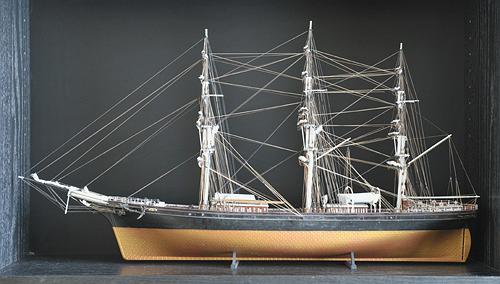
Grandfather insisted for all his life that the Cutty Sark was only cut down in 1881 after he left her, and his copy of the
Log, dedicated to him by the author, Basil Lubbock, contains an indignant correction to this effect. And grandfather offered specific
evidence: the dock order specified that stunsails were to be removed, whereas at least some were still present during his voyage.
"Cutting down" a ship's rig was done in most cases simply to save money, which indeed is what Jock Willis had in mind. It was
considered an indignity by seamen, which is why Lubbock preferred the date on the dock order to Grandfather's view in this specific
instance, although he relied heavily upon Grandfather's journal when writing of the voyages in which he took part. I suspect that
there were two cuttings-down, the first at the date of the dock order that left at least some stunsails, the second in 1881, after
grandfather left her, that removed all the stunsails and perhaps shortened the upper yards even more.
G.F.Campbell made detailed drawings of her 1870 tea rig for the Cutty Sark Preservation Society, which are essential for any
accurate model. However, see my companion page on The Painting of the Ship Cutty Sark
before you start painting anything - several of Campbell's colours are wrong. It's not easy repainting deckhouses and blocks
through a forest of rigging as I've had to.
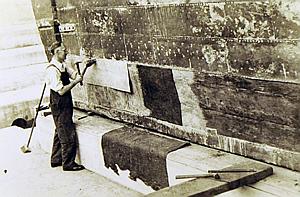
After surviving WW2 bombs, being rejected by the National Maritime Museum and about to be broken up by the training college that
then owned her, she was saved by the London County Council and placed in a display dry dock at Greenwich England under
royal patronage.
There were several terrible decisions made at that time, mostly due to lack of funds. The worst by far was to cut two gaping
holes through her fine hull so the hold could be used for display rooms; she could never sail again. And, since she was rebuilt
to the early tea trade specifications, most of the masting and rigging has never seen salt water, and one of the deckhouses,
expanded in later sailing years, was replaced as well. Her hull was prettied up with new sheathing (shown here during my first
visit in 1955). As if that wasn't enough, almost all the original teak deck was replaced by new material in the early 1970s
and her original decking was thrown out.
There were also two curious and highly visible decisions made then with regards to painting. Based apparently on the
secondary evidence of a single painting once owned by Jock Willis, and contrary to
documents and photos of the time, the house panels and wood masts were varnished
rather than being painted white and black respectively.
And now, thanks to a faulty vacuum cleaner, even more of her is gone.

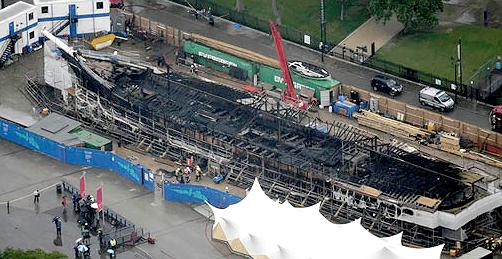
I hoped that, after the fire, the Cutty Sark Trust would follow the magnificent
example of Coventry Cathedral. After its destruction, there was no pretence made that 1945 was the 14th century. Instead,
the ruins were stabilized and left as a monument to the destruction of war. A new cathedral was built in the spirit of its own
time, one that has attracted so much pride over the years that in the mid-1960s when I visited, I calculated that if 2s had been
paid by each visitor by that time, the amount would already have been sufficient to pay for its entire construction. But, for the
Cutty Sark, it isn't to be.
Sadly, the Trust is rebuilding her after the fire as a tourist attraction, replacing damaged elements, pretending that
nothing has happened, and are hoisting her up into the air like a Disneyworld Peter Pan pirate ship. They are even inventing
'crew quarters' on the main deck rather than buried in the forecastle so they'll be handicap-accessible. That is fake.
The Cutty Sark was genuine. She was a flower of the tea trade, a hard working tramp carrier, the greyhound of the wool trade,
once again a general cargo carrier, then a teaching ship, all of it for real. She experienced the ice of the north Atlantic and the
southern seas, the heat of the Doldrums and one of the largest waves ever recorded; salt spray all the time. She was almost the last
survivor of a British technical tour-de-force, the marriage of the strength of a steel hull with the anti-fouling capabilities then
only available with copper. And, she is a symbol of the British mariners who built the empire on which the sun never set.
She was all ship. Her spirit and that of her age should be conserved too, not just her fabric.
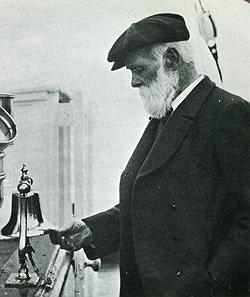 She could be lifted just enough to correct the sagging that has resulted from having all her weight on her keel for so long.
She could be placed alongside the port wall of the drydock, with visitor access to view her hull the other side.
The port side could be a timber dock, made of timbers of her
time from one of the many ports she visited. Access to her deck could then be by gangplank through the taffrail sections
used for access throughout her life, and could even be handicap-accessible without destruction of fabric. As the only surviving
extreme clipper with full stunsails, she could have all her working lines installed, not just a few as at present, to show
dramatically to all who visit the skill required of an able seaman, to correct the dismissive landlubbers' distortions
of those who sailed her and her contemporaries.
She could be lifted just enough to correct the sagging that has resulted from having all her weight on her keel for so long.
She could be placed alongside the port wall of the drydock, with visitor access to view her hull the other side.
The port side could be a timber dock, made of timbers of her
time from one of the many ports she visited. Access to her deck could then be by gangplank through the taffrail sections
used for access throughout her life, and could even be handicap-accessible without destruction of fabric. As the only surviving
extreme clipper with full stunsails, she could have all her working lines installed, not just a few as at present, to show
dramatically to all who visit the skill required of an able seaman, to correct the dismissive landlubbers' distortions
of those who sailed her and her contemporaries.
My grandfather can never stand on her again, as Captain Woodget was able to when she was returned to the British flag.
But, if he could, I wish with all my heart that he could recognize the spirit of the ship he sailed on so many years ago.
John Sankey
other notes on family history
The Ordeal of the Cutty Sark
An Early Model of the Cutty Sark
The Painting of the Ship Cutty Sark
Jock Willis' Specification for the Cutty Sark
The Georg Stage: a modern clewed-to-quarters ship








 She could be lifted just enough to correct the sagging that has resulted from having all her weight on her keel for so long.
She could be placed alongside the port wall of the drydock, with visitor access to view her hull the other side.
The port side could be a timber dock, made of timbers of her
time from one of the many ports she visited. Access to her deck could then be by gangplank through the taffrail sections
used for access throughout her life, and could even be handicap-accessible without destruction of fabric. As the only surviving
extreme clipper with full stunsails, she could have all her working lines installed, not just a few as at present, to show
dramatically to all who visit the skill required of an able seaman, to correct the dismissive landlubbers' distortions
of those who sailed her and her contemporaries.
She could be lifted just enough to correct the sagging that has resulted from having all her weight on her keel for so long.
She could be placed alongside the port wall of the drydock, with visitor access to view her hull the other side.
The port side could be a timber dock, made of timbers of her
time from one of the many ports she visited. Access to her deck could then be by gangplank through the taffrail sections
used for access throughout her life, and could even be handicap-accessible without destruction of fabric. As the only surviving
extreme clipper with full stunsails, she could have all her working lines installed, not just a few as at present, to show
dramatically to all who visit the skill required of an able seaman, to correct the dismissive landlubbers' distortions
of those who sailed her and her contemporaries.